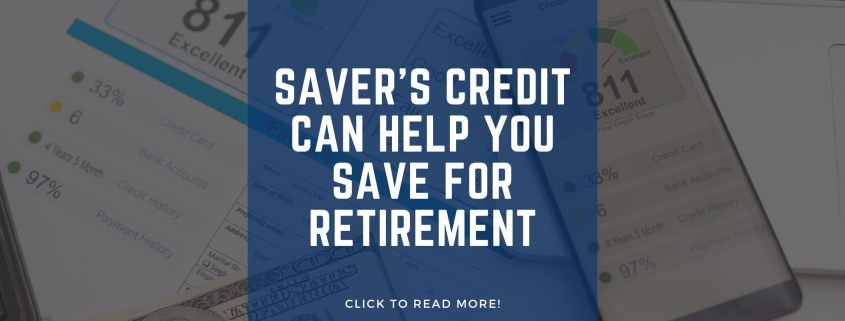Saver’s Credit Can Help You Save for Retirement
- Learn about the benefits of the retirement savings credit.
- Learn what taxpayers are eligible for the credit.
- Understand the rules for students, dependents of others, and individuals under the age of 18.
- Find the due date for contributions.
Low- and moderate-income workers can take steps to save for retirement and earn a special tax credit.
The saver’s credit also called the retirement savings credit, helps offset part of the first $2,000 workers voluntarily contribute to eligible retirement accounts. Eligible accounts would include: traditional or Roth individual retirement arrangements (IRAs), SIMPLE IRAs, SEPs, 401(k) plans, 403(b) plans for employees of public schools and certain tax-exempt organizations, 457 plans for state or local government employees, and the Thrift Savings Plan for federal employees. The saver’s credit is available in addition to any other tax savings that apply as a result of contributing to retirement plans. Self-employed individuals may also enjoy the benefit of the credit.
Credits are determined from the tables shown below and are based on both filing status and income (AGI). Each year the tables are adjusted for inflation and the tables for 2023 and 2024 are illustrated below.


Modified AGI
Modified AGI is determined without regard to the foreign earned income exclusion (also applies to US possessions) and foreign housing exclusion or deduction.
Like other tax credits, the saver’s credit can increase a taxpayer’s refund or reduce the tax owed. Though the maximum saver’s credit is $1,000 ($2,000 for married couples if both spouses contribute to a plan), taxpayers are cautioned that it is often much less and (due in part to the impact of other deductions and credits) may be zero for some taxpayers.
Calculating Saver’s Credit
The amount of a taxpayer’s saver’s credit is based on a few factors; their filing status, adjusted gross income, tax liability, and amount contributed to qualifying retirement programs.

This example from 2023 illustrates how the credit phases out for higher-AGI taxpayers. In this example, the couple’s AGI of $40,000 limits the credit to 20% of their qualifying contributions. Had their AGI been $43,500 or less, their credit percentage would have been 50% of their qualified contributions; a total credit of $1,250.
Saver’s Credit Eligibility
The saver’s credit supplements the other tax benefits available to people who set money aside for retirement. Generally, except for Roth IRA contributions, workers’ contributions to retirement plans are tax deductible. Either in the form of a deduction on their tax return (traditional IRAs and certain self-employed retirement plans) or through a reduction of wages that would otherwise be taxable. Taxable wages would include pre-tax contributions to a 401(k), 403(b), etc. So, in addition to the saver’s credit, contributions to retirement plans provide a tax deduction for traditional IRAs or income reductions for certain other plans. This lowers an individual’s tax before the credit is applied. The credit itself can only be used to reduce taxes (income and alternative minimum taxes only) to zero. Any amount in excess of a taxpayer’s tax liability is lost.
Additional Special Rules
Other special rules that apply to the saver’s credit include the following:
- Eligible taxpayers must be at least 18 years of age.
- Anyone claimed as a dependent on someone else’s return cannot take the credit.
- A full-time student cannot take the credit. A person enrolled as a full-time student during any part of five calendar months during the year is considered a full-time student.
The credit is provided to encourage taxpayers to save for retirement. To prevent taxpayers from taking distributions from existing retirement savings and re-depositing them to claim the credit, qualifying retirement contributions used to figure the credit are reduced by any retirement plan distributions taken during a “testing period”. The testing period includes the prior two tax years, the current year, and the subsequent tax year before the due date (including extensions) for filing the taxpayer's return for the tax year of the credit.

How to Take Advantage of the Saver’s Credit
As you can see, qualifying for and using this credit involves following a complicated set of rules, but the credit can be very beneficial. If you are not sure you can afford to fund your retirement plan, contributions to an IRA or a self-employed retirement plan (SEP) can be made after the close of the year. This allows you time to determine the tax benefit of the saver’s credit and your overall tax refund before you contribute to one of those plans. For example, IRA contributions for 2023 can be made up to April 15, 2024. Alternatively, SEP contributions can be made until October 15, 2024, if your return is on extension.
If you have questions about how this tax benefit might apply in your situation, request a consultation with a local Fiducial Advisor. Click here to Request a consultation with a Fiducial Advisor at our office locations.
Know someone who might need our services? We love referrals!









